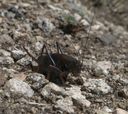Shield-backed Katydids
Tettigoniinae
Classification
- Phylum: Arthropoda
- Subphylum: Hexapoda
- Class: Insecta
- Order: Orthoptera
- Suborder: Ensifera
- Infraorder: Tettigoniidea
- Family: Tettigoniidae
- Subfamily: Tettigoniinae
Pronunciation
How to pronounce Tettigoniinae: //ˌtɛtɪˈɡoʊniɪni//
These audio files are automatically generated. While they are not always 100% accurate, they are a good starting point.
Images






Summary
The Tettigoniinae is a diverse subfamily of katydids characterized by their shield-like pronotum, varied diet, and significant presence across several continents, particularly in North America and the Palaearctic region. They are known for being active predators of insects and can also impact agricultural crops when present in large numbers.
Physical Characteristics
18-50 mm in size, usually have short wings, brown or black coloration, and a shield-like pronotum that extends back over wings. True 'shieldbacks' such as Atlanticus have reduced wings, especially in females, making them flightless.
Identification Tips
Resemble robust crickets and can be identified by their distinctive shield-like pronotum and typically short wings.
Habitat
Varied habitats including open country, croplands, and a few in forests.
Distribution
Native to the Americas, Australia, southern Africa, Europe (especially Mediterranean), and the Near East. The greatest diversity is found in the Palaearctic region with substantial representation in North America.
Diet
Some species are active predators of other insects while many also consume plant material and scavenge dead insects.
Life Cycle
Generally complete metamorphosis including egg, nymph, and adult stages, with activity occurring in summer through early fall.
Reproduction
Eggs are usually laid in the soil or plant material; specific reproductive behaviors may vary by genus.
Ecosystem Role
They serve both as predators of other insects and as prey for various animals, maintaining a balance in their ecosystems.
Economic Impact
Some species, such as the Mormon cricket (Anabrus simplex), can become pests in agricultural settings, causing damage to crops.
Cultural Significance
In Europe, referred to as 'Wart Biters'. They may be noted in local folklore or as part of entomological studies due to their unique characteristics and behaviors.
Health Concerns
May bite if handled; caution is advised when interacting with them.
Evolution
Represent an ancient Gondwana fauna, with relationships indicated among genera across different continents due to historical geographical connections.
Similar Taxa
- Orthoptera
- Decticinae
- Gampsocleis
- Pholidoptera
Misconceptions
Often misidentified as crickets due to their similarity in appearance; also, the name 'Wart Biters' can lead to misunderstanding about their behavior.
Tags
- Tettigoniinae
- katydids
- Shield-backed Katydids
- Orthoptera
- insects
- North America